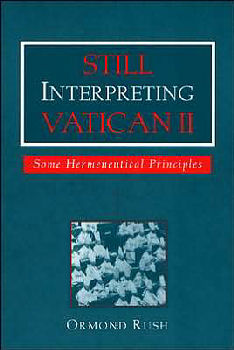
|
Posted April 23, 2006
Book: Still Interpreting Vatican II: Some Hermeneutical Principles Author: Ormond Rush Paulist Press, NY, 2006, pp. 125 An Excerpt from the Book:
Finally, Still Interpreting Vatican II concludes with a proposal that believers see the Holy Spirit at work not only in the Council’s letter and spirit, but in the continuing act and challenge of receiving the Council at the dawn of the third millennium. By pursuing these three hermeneutics and recognizing that the Spirit is still at work, the current impasses over interpreting Vatican II may yet be broken. An Excerpt from the Book: Interpretation of the meaning of Vatican II and its documents does not end with a historical reconstruction centered on those four years in the early 1960s. Nor does it end with a textual examination of its documents. The last forty years have now become part of the meaning of the Council. The history of the Council includes the history of its reception. Indeed, the historical meaning, or significance, of Vatican II in the sweep of church history is now dependent on those who receive it and will (or will not) make it significant. As Kasper states it: Whether this council will count in the end as one of the highlights of church history will depend on the people who translate its words into terms of real life. What is at issue for Catholic theology, therefore, is not the council in itself. What is in question is the interpretation and reception of the council. The dispute is about this and this alone. Likewise, Ratzinger highlights the importance of post-conciliar reception by the whole church in the determination of a Council’s effectiveness. While the Council formulated its pronouncements with the fullness of power that resides in it, its historical significance will be determined by the process of clarification and elimination that takes place subsequently in the life of the Church. In this way, the whole Church participates in the Council; it does not come to an end in the assembly of bishops. Table of Contents: 1. A hermeneutics of the authors 2. A hermeneutics of the texts 3. A hermeneutics of the receivers 4. A new Pentecost: a new pneumatology 5. Notes |
|
